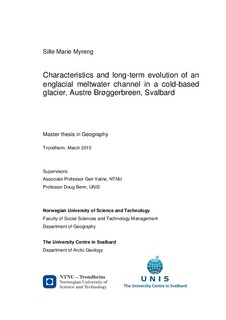| dc.description.abstract | This thesis aims to describe the long-term evolution of the profile and planar pattern of an englacial channel, and to find the main factors and processes controlling its development. The main topics to be addressed are the development of steps and meanders, and the formation of an englacial channel and a moulin in uncrevassed ice. To achieve this, the available literature on the subject is reviewed, and then applied to the interpretation of a series of four speleological surveys done in the upper part of an englacial channel in Austre Brøggerbreen, Svalbard, in the period between 2002 and 2014. In addition, a total of 6 dye tracer experiments from 2005 and 2014 are analysed to find the flow conditions through the entire englacial system.
The results show an englacial channel that develops toward a concentration of the elevation drop to a few, short sections of the total channel length, separated by long, near-horizontal channel reaches. The meanders grow in wavelength and radius of curvature over time, to accommodate the increase in stream width which in turn comes from a decrease in slope. Both upstream step migration and downward incision of the near-horizontal channel reaches are contributing to the overall channel lowering.
The englacial channel originated from a supraglacial channel, and has entered the englacial environment by the process of cut-and-closure. The differences in slope on the glacier surface is thought to have led one part of the channel to incise down into the englacial environment, while the upstream part with lower gradient remained on the glacier surface. The growing difference in depth between the two channel parts, in combination with the reduced upstream migration of the englacial entrance by the detachment of the jet flow over the entrance step, is believed to be the main processes behind the transition from a gentle sloping channel to a 43 m deep, vertical moulin.
The data series presented in this study holds a great potential for further investigations, but more surveys of better accuracy and higher temporal and spatial resolution are needed to pin
down the exact rates and processes of englacial channel pattern development. | nb_NO |
